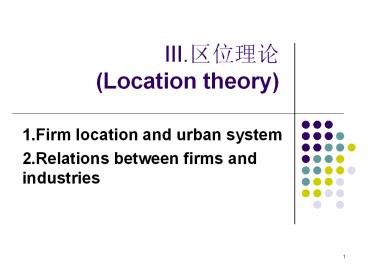III.???? (Location theory) - PowerPoint PPT Presentation
1 / 30
Title:
III.???? (Location theory)
Description:
III. (Location theory) 1.Firm location and urban system 2.Relations between firms and industries 1. firm location + urban system ... – PowerPoint PPT presentation
Number of Views:133
Avg rating:3.0/5.0
Title: III.???? (Location theory)
1
III.????(Location theory)
- 1.Firm location and urban system
- 2.Relations between firms and industries
2
1. firm location urban system
- ?????
- ?????
- ?????
- ?????
3
1)????????
- Thunen,1826,
- ??????????????
- ?????????????(???????????),????????????
- Optimal agricultural land uses based on transport
costs to market
4
??
- ????
- 1.?????????????
- 2.??????????
- 3.??????,?????????
- 4.???50???????,???????
- 5.??????????????,?????????????
- 6.????????????
- ??????
- R(P-C-Kt)Q
- P???????C???Q??K???(??)???t???
- ????(??????????)
5
????????????,???????????????????????
- ????????
- ?????
- ?????(???)
- ???????????
- ??????(?????????)
- ?????(???51-80???,????,????)
6
?????
- ??????????????
- ????(Sinclair,1967)
- ?????,????????????????????,????
- William Alonso (1933-1999)
- Optimal distances of residential and commercial
land uses from CBD
7
2)????????Alfred Weber, 1909 ???????????
- ??????,????????
- ?????????????????
- ???????????????????
- ?????????????????
8
?????????????????
9
????????(Varignnon Frame)
10
3)Hoover?????1948???????
- ???????????????(????,??,??,?????????)???????(????
,??,??????,????,????????)? - ?????????,?????????????????????????
- ?????????????????,??????????????????,??????????
- ??????,????????????????????????????
- An Introduction to Regional EconomicsEdgar M.
Hoover and Frank Giarratani - http//www.rri.wvu.edu/WebBook/Giarratani/cont
ents.htm
11
????????
- ?????????????,?????????????????????????????????,
?????????????????,??????????????????,???????? - (?????/just-in-time/????)
- ?????????(????????),??????????????
12
4)????????Losch, 1940, ??????
- market-oriented?????????????--???
- ?????????,????????????
- --????????????,?????????????????????,????????
13
5)?????(central place theory) ????? Christaller
, 1933
- ????????????--???,???,???????,????????????????????
???? - ??????(????)
- ???
14
2. relations between firms industries
??????????
15
1)?????(spatial competition for market
share)????????
- ?????(Hotelling model) Hotelling, 1929,
Stability in competition, Economic Journal,
341-57. - two ice cream vendors on the beach to share
market attendance for spatial concentration
16
Hotelling Modellocations of venders on the beach
17
2)??(agglomeration)
- ????????(agglomeration economies) ?????(Hoover,
1937) - I.????(scale economies)
- II.?????(localization economies)
- III. ?????(urbanization economies)
18
- I.????(scale economies)
- ???????????????????????????????????????????????,
??????????????????????????. - II. ?????(localization economies)????????????????
????????????????????????????????,?????????????????
?????????share labor pool, suppliers, etc. - III.????? (urbanization economies)
- ???????????????????????????
- a) ????????(e.g. subway), ????
- b) ???versatility, e.g. New York, fashion
industry
19
???????????(external scale economies)
- Marshall (1890 1961) defines external scale
economies as cost savings accruing to the firm
because of size or growth of output in industry
generally. Such economies contrast directly with
internal scale economies, which are the source of
increasing returns from growth in the size of
plant. Such external economies are essentially
spatial externalities, which may be defined
generally as economic side-effects of proximity
between economic actors. They can be either
negative or positive, static or dynamic,
pecuniary or technological. The static variety
are reversible, whereas dynamic externalities are
those associated with the technological advances,
increased specialization, and division of labor
that accompanies and/or drives growth and
development (Young 1928).
20
external scale economies??? (Marshall, 1890
1961)
- a. (???)???? ??????????,???????,??/????
- b.????? land cost, congestion, etc.
- ?change cost patterns (e.g. labor cost rises)
- ? increase productivity or decline
21
????
- Vernon (1960) the case of New York
- a. versatility
- b. skillful labor
- c. small firms specialized
- d. face to face contact
- e. ???????? (E.g. Specific machine)
- f. ???(suppliers)
- --backward/forward linkages
22
3)linkage studies
- 50-60s, mapping the relations between sectors and
economies - linkages the contacts and flows of information
and/or materials between two or more individuals. - --indicate the interdependence among firms and
its effects on location
23
linkages
- forward linkages market-orientedproducer and
customers - backward linkages producers and suppliers (of
goods and services) - sideways interaction with other firms involved
in the same process
24
sectoral relations
- input-output models, Wassily Leontief
transaction table - The production (or output) of one sector become
the inputs for other sectors - Input-output analysis(IO)
- (http//faculty.washington.edu/krumme/207/inputout
put.html)
25
Input-output table for Mexico, 1980(rowssales/
columnspurchases)
26
?linkage studies???
- which linkages matter?
- Goods/markets/services/ information/technology
27
4)????(path dependency) ???????
- ? QWERTY?????????,??????????(lock in)?
28
Krugman (1991, p. 60) cites the carpet industry
in Dalton, Georgia.
- . . .in 1895 the teenaged Miss Evans made a
bedspread as a gift. The recipients and their
neighbors were delighted with the gift, and over
the next few years Miss Evans made a number of
tufted items, discovering in 1900 a trick of
locking the tufts into the backing. She now began
to sell the bedspreads, and she and her friends
and neighbors launched a local handicraft
industry that began selling items well beyond the
immediate vicinity.
29
Path Dependency
- There was no carpet technology institute at the
local university, no cluster of carpet producers
in the region, and no history of carpet making
among local workers. Yet Dalton became a leader
in carpet production (indeed, a carpet industry
cluster), scale economies and externalities
reinforced its lead, and the rest is history.
Because technology can be path dependent,
regional development trajectories can become path
dependent.
30
Reference
- An Introduction to Regional EconomicsEdgar M.
Hoover and Frank Giarratani - http//www.rri.wvu.edu/WebBook/Giarratani/cont
ents.htm - ???,p.50-53
- ???,1999, ?????,?????, ???????
- Krugman, Geography and Trade
- Leon Moses, "Location and the Theory of
Production," Quarterly Journal of Economics,
vol.72, 1958, pp.259-72.

